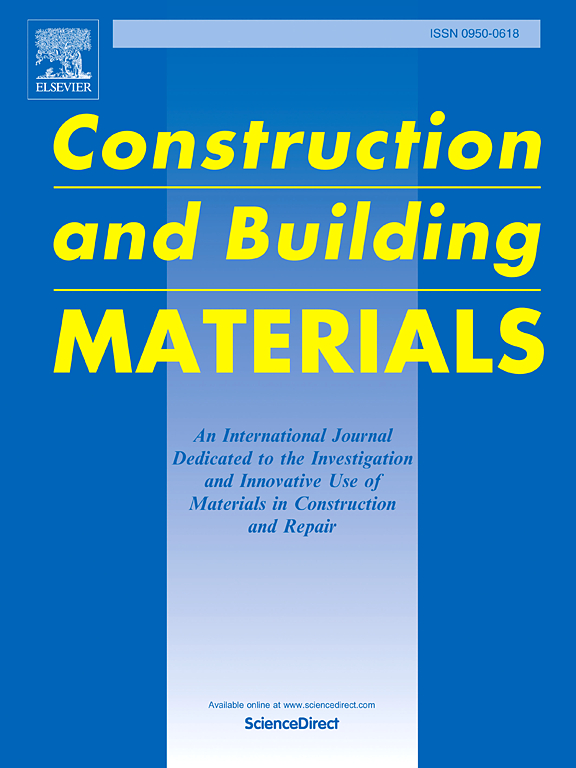Effect of tea stalk biochar derived from pyrolysis at different temperatures on adsorption capacity of asphalt fume
IF 7.4
1区 工程技术
Q1 CONSTRUCTION & BUILDING TECHNOLOGY
引用次数: 0
Abstract
Asphalt fumes released at high temperatures significantly impact human health and the natural environment. This study systematically investigated the microstructure and compositional characteristics of tea stalk biochar (TB) from pyrolysis at different temperatures (300℃, 400℃, 500℃, and 600℃) and its adsorption capacity for asphalt fumes. Scanning electron microscopy and Brunauer-Emmett-Teller analysis indicated that increasing pyrolysis temperatures enhanced the porosity and BET surface area of TB, transitioning its structure from dense and low-porosity to highly porous. Fourier-transform infrared spectroscopy and elemental analysis revealed that higher temperatures promoted biochar graphitization, reduced oxygen-containing functional groups, and increased hydrophobicity and aromaticity. Analysis of asphalt fumes demonstrated that adding 1 % TB significantly reduced asphalt fume emissions, including VOCs, H₂S, SO₂, and NOₓ. TB prepared at 500℃ (500TB) exhibited optimal adsorption, reducing VOCs by 68.6 % and H₂S by 87.5 %. GC-MS analysis further revealed that 1 % 500TB reduced aliphatic hydrocarbons, aromatic compounds, oxygen-containing compounds, and sulfur-containing compounds in asphalt VOCs by 63 %, 69 %, 67.2 %, and 63.3 %, respectively. The superior adsorption performance of 500TB was attributed to its larger surface area, diverse mesoporous structure, and high aromatic carbon content, enhancing its affinity for pollutants. Physical tests indicated that biochar enhances the thermal stability and deformation resistance of asphalt by increasing its softening point, viscosity, and penetration index, while maintaining acceptable ductility. These findings demonstrate the effectiveness of TB for mitigating asphalt fume emissions.
不同热解温度下茶茎生物炭对沥青烟吸附能力的影响
高温下释放的沥青烟雾严重影响人类健康和自然环境。本研究系统研究了不同热解温度(300℃、400℃、500℃和600℃)下茶茎生物炭(TB)的微观结构、组成特征及其对沥青烟气的吸附能力。扫描电镜和brunauer - emmet - teller分析表明,随着热解温度的升高,TB的孔隙率和BET比表面积增大,其结构从致密的低孔隙度向高孔隙度转变。傅里叶变换红外光谱和元素分析表明,较高的温度促进了生物炭的石墨化,减少了含氧官能团,提高了疏水性和芳香性。对沥青油烟的分析表明,添加1 % TB可显著减少沥青油烟的排放,包括VOCs、h2s、SO₂和NOₓ。在500℃(500TB)条件下制备的TB表现出最佳的吸附效果,VOCs和h2s分别降低了68.6% %和87.5 %。GC-MS分析进一步表明,1 % 500TB分别使沥青VOCs中的脂肪族烃、芳香族化合物、含氧化合物和含硫化合物减少63 %、69 %、67.2 %和63.3 %。500TB优异的吸附性能源于其较大的比表面积、多样的介孔结构和较高的芳碳含量,增强了其对污染物的亲和力。物理试验表明,生物炭通过提高沥青的软化点、粘度和渗透指数来增强沥青的热稳定性和抗变形能力,同时保持可接受的延性。这些发现证明了结核对减轻沥青烟雾排放的有效性。
本文章由计算机程序翻译,如有差异,请以英文原文为准。
求助全文
约1分钟内获得全文
求助全文
来源期刊

Construction and Building Materials
工程技术-材料科学:综合
CiteScore
13.80
自引率
21.60%
发文量
3632
审稿时长
82 days
期刊介绍:
Construction and Building Materials offers an international platform for sharing innovative and original research and development in the realm of construction and building materials, along with their practical applications in new projects and repair practices. The journal publishes a diverse array of pioneering research and application papers, detailing laboratory investigations and, to a limited extent, numerical analyses or reports on full-scale projects. Multi-part papers are discouraged.
Additionally, Construction and Building Materials features comprehensive case studies and insightful review articles that contribute to new insights in the field. Our focus is on papers related to construction materials, excluding those on structural engineering, geotechnics, and unbound highway layers. Covered materials and technologies encompass cement, concrete reinforcement, bricks and mortars, additives, corrosion technology, ceramics, timber, steel, polymers, glass fibers, recycled materials, bamboo, rammed earth, non-conventional building materials, bituminous materials, and applications in railway materials.
 求助内容:
求助内容: 应助结果提醒方式:
应助结果提醒方式:


